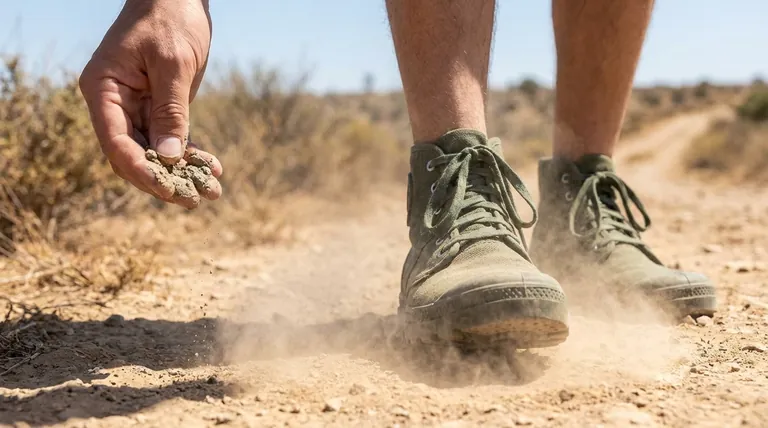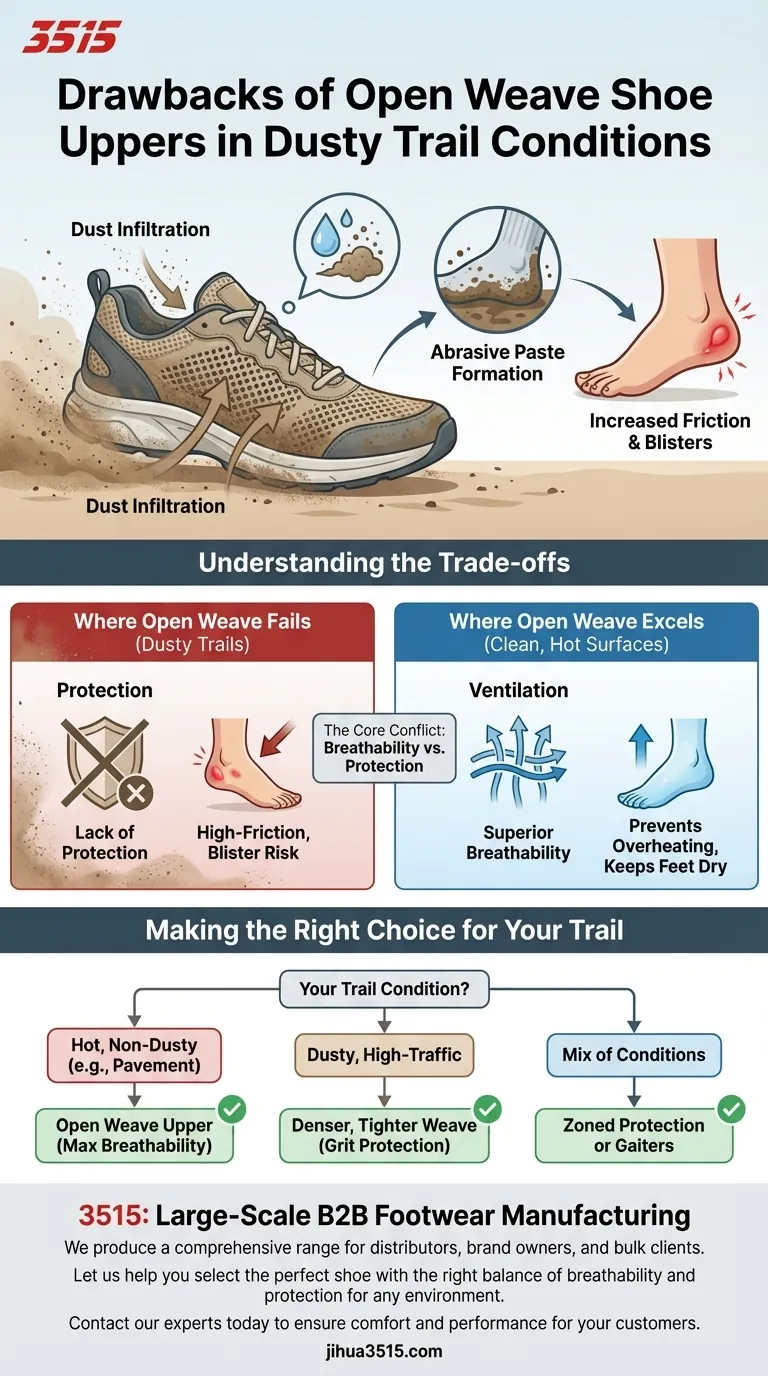The primary drawback of open weave shoe uppers in dusty conditions is their permeability. They allow fine grit and dust to penetrate the shoe, which then mixes with sweat to create an abrasive internal environment that directly leads to friction, hotspots, and painful blisters.
The core issue is a trade-off: the exceptional breathability that makes open weave uppers desirable in clean, hot conditions becomes a significant liability on dusty trails, sacrificing protection for airflow.

The Primary Problem: Dust Infiltration
The very structure that makes an open weave upper breathable is what allows fine particulate matter to enter. This isn't just an annoyance; it's a direct cause of foot damage during a run or hike.
How Fine Grit Enters the Shoe
An open weave is, by design, a porous material. While it excels at letting heat and vapor escape, it offers little resistance to the fine, powdery dust kicked up on heavily trafficked or dry trails.
Each footfall sends clouds of this dust into the air, much of which settles on and passes directly through the upper material into the sock and shoe interior.
The Abrasive Paste Effect
Once inside, this dry grit mixes with the natural sweat from your foot. This combination creates a muddy, gritty paste that coats your sock and skin.
This paste acts like a low-grade sandpaper, dramatically increasing friction with every step you take.
The Inevitable Consequence: Blisters
Constant friction from this abrasive internal environment is the leading cause of hotspots and blisters. What might be a minor rubbing issue in a clean shoe quickly escalates into a painful blister when grit is introduced.
This can shorten or ruin an outing and significantly increase recovery time.
Understanding the Trade-offs
Choosing a shoe upper is never about finding a single "best" material, but about matching the material's properties to your most common environment. Open weave uppers present a classic conflict between breathability and protection.
Where Open Weave Fails
On dusty, loose trails, the open weave's lack of protection is a clear disadvantage. The constant infiltration of grit creates a high-friction environment that is a direct threat to foot health.
These materials are also more susceptible to staining from dirt and can be more prone to snagging and abrasion compared to tighter, more robust weaves.
Where Open Weave Excels
In contrast, during hot runs on clean surfaces like pavement, rock, or well-maintained trails, an open weave is superior. Its ability to ventilate prevents overheating and moisture buildup, keeping feet cooler and drier.
Making the Right Choice for Your Trail
To avoid discomfort and injury, select your footwear based on the reality of the trails you frequent most often.
- If your primary focus is running in hot, non-dusty conditions: An open weave upper is an excellent choice for maximum breathability and comfort.
- If your primary focus is running on dusty, high-traffic trails: Prioritize a shoe with a denser, more tightly woven upper to protect your feet from grit infiltration.
- If your primary focus is a mix of conditions: Consider a shoe with zoned protection, featuring a tighter weave in high-impact areas and more open mesh in others, or use gaiters to supplement protection.
Ultimately, aligning your shoe's construction with your environment is the most critical step in ensuring comfort and performance on the trail.
Summary Table:
| Drawback | Consequence |
|---|---|
| Dust & Grit Infiltration | Fine particles enter through the porous material. |
| Abrasive Paste Formation | Grit mixes with sweat, creating a sandpaper-like paste inside the shoe. |
| Increased Friction & Blisters | The abrasive environment leads to hotspots and painful foot damage. |
| Lack of Protection | Excellent breathability comes at the cost of a protective barrier. |
Don't let the wrong shoe upper ruin your hike or run.
As a large-scale manufacturer, 3515 produces a comprehensive range of performance footwear for distributors, brand owners, and bulk clients. We can help you select or develop the perfect shoe with the right balance of breathability and protection for any environment, from dusty trails to clean pavement.
Contact our experts today to discuss your footwear needs and ensure comfort and performance for your customers.
Visual Guide

Related Products
- Factory-Direct Wholesale Canvas Boots with High-Traction Rubber Soles
- Safety Footwear Wholesale Manufacturer for Custom OEM/ODM Production
- Factory Direct Wholesale Rain Boots Durable Waterproof & Fully Customizable
- Wholesale Safety Footwear Manufacturer for Bulk & Custom OEM Orders
- Wholesale Anti-Smash & Puncture-Proof Safety Shoes Custom Manufacturing for Brands
People Also Ask
- Why is rubber a popular material for shoe soles? Unbeatable Grip, Durability & Value
- What role do slip-resistant rubber materials play in safety shoes? Ensuring Grip and Stability in Hazardous Workplaces
- Why is rubber commonly used for non-slip soles? The Science of Superior Grip
- What factors determine the slip resistance of rubber-soled shoes? Tread, Compound & Design Explained
- Why are rubber soles beneficial in cold-weather boots? Superior Traction & Waterproofing



















